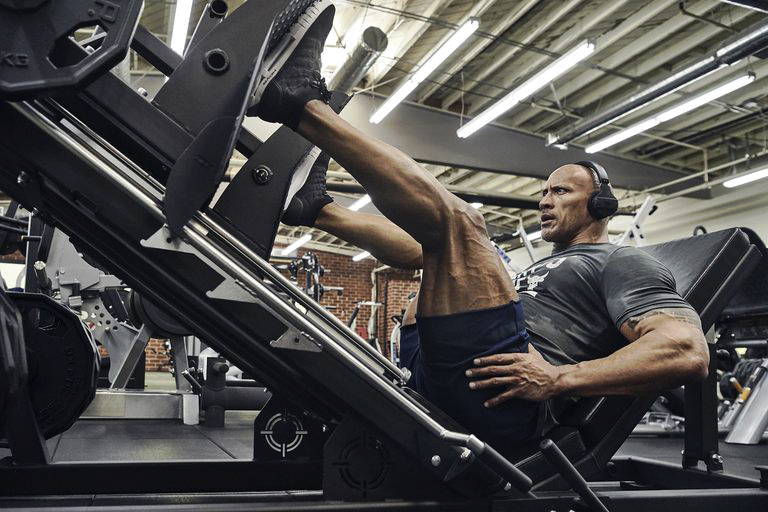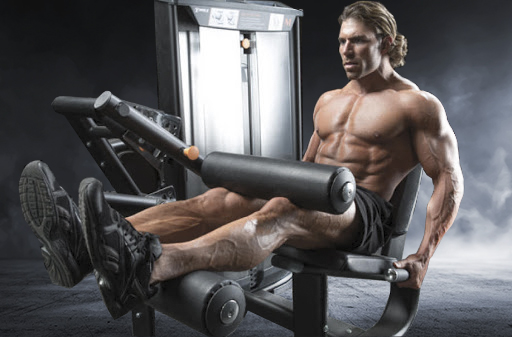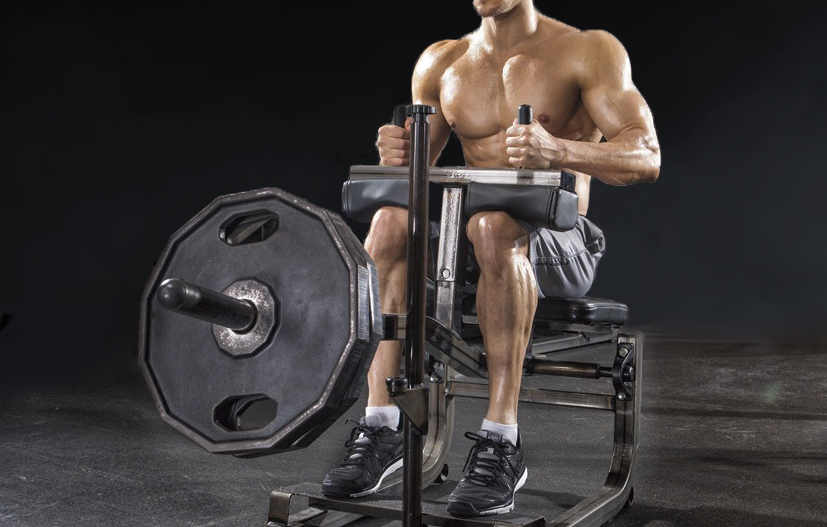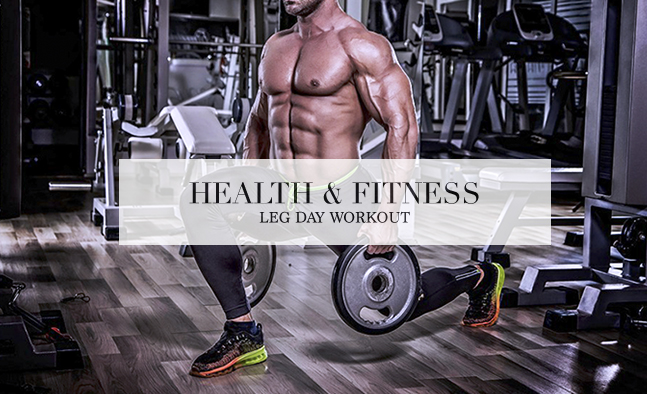Add serious size and strength to your legs with this intense leg workout. Seven exercises to build the legs you’ve always wanted.
Many put off leg day but it’s an essential part in building an aesthetic symmetrical physique. Not only that, the legs are a large muscle group. If they are periodically stimulated this will help immensely to maintain body fat levels or even help to reduce it. Furthermore, stimulation of the leg muscles will induce the release of muscle building hormones – specifically testosterone – within the body, more so than any other muscle group. If you are one of those that guys that have put legs on a back burner, then you may want a rethink.
The major leg muscle regions that we will target during this leg workout will include the glutes, hamstrings, quadriceps, calves, abductors and the adductor muscles. This is a great leg workout that doesn’t involve the squat as a foundation leg building exercise.
Though the squat is one of the best exercises for building overall strength and size in your legs, many people do struggle to execute the movement properly and just find it an uncomfortable movement. This could be due to their skeletal structure making executing the movement more difficult compared to other people. This exercise emphasises the leg press as the foundation for this killer leg workout. The leg press can be a great tool to build serious strength and size in your legs.
If you want to increase muscle definition in your legs, build-up the size and strength of the leg muscles, then this 45-minute leg workout is for you.
So get ready to build up some impressive legs that you will be proud to show off.
The Leg Workout
Leg Press Machine
Sets 5 Reps 12 Rest 90 Sec
The leg press will be the foundation of this leg building programme. Your goal is to go heavy, pressing as much weight as you can, over time. For this reason, the leg press exercise is placed at the very start of the leg workout where you have maximum energy. If you placed this further on into the leg workout you would notice a significant decrease in maximal weight load pressed due to onset of muscle fatigue.
The leg press machine often gets performed with poor form and too much weight pressed. This can lead to lower-back injury often caused when the lower back disengages from the pad on each rep, in part due to inflexibility in the glutes and hamstrings.

There are variations to this exercise you should consider including. Your feet position can determine the level of tension placed on the different muscles. Placing the feet higher on the plate, whilst still hitting the quads, will further activate the glutes and hamstrings, placing them under greater tension. By placing your feet lower on the plate, tension will be emphasised on the quads to a much greater extent and less so on the hamstrings. A wide stance will help to activate the inner thigh muscles and a narrow stance will help to activate the outer thigh muscles.
Stick with this exercise, the leg press is one of the best pieces of equipment for developing big quad muscles. As we have stated, this leg exercise is the foundation for this leg workout program.
Areas Targeted: Quadriceps, glutes and hamstrings.
How To:
- Lay back in the leg press machine with your back flush against the pad.
- Place your feet shoulder-width apart on the plate.
- Tighten your core muscles then push through your legs to lift the plate.
- Carefully unlatch the plate from the safety feature with both hands simultaneously.
- Controllably, bend your knees to lower the platform, stopping before your lower back and glutes lift of the pad beneath it.
- Next, by engaging the target muscles first, press the weight back up, ensuring, however, that you do not lock-out your knees at the top.
- Repeat
Barbell Hip Thrusts
Sets 3 Reps 10 Rest 90 sec
The barbell hip thrust is a compound movement and a great exercise to challenge the glutes and hamstrings. It is one of the best exercises to target, specifically, the glutes (gluteus maximus, medias and minimus). The hamstrings contribute to hip extension (pushing hips forward) and will act as the synergist (assisting) muscle in the movement.
If you want to improve the glute size, strength, and power, then the hip thrust should, without a doubt, be included in your fitness regime.
The reason why hip thrusts target your glutes so well is due to the angle of the knee. The bent knee that is maintained during the entire movement of this exercise renders the hamstrings, to the best part, inactive – this leaves most of the hip extension stemming from the glutes.
A lot of exercises that improve the hypertrophy and strength of the legs, such as squats and leg presses, do not maximise hip extension – which is key for targeting the glutes – therefore, the glutes, in these instances, are not fully engaged. By isolating the glutes, you can increase the power and overall performance in exercises that require a strong hip drive, such as the squat, while improving stability in your core and hips.
As you now see the hip thrust is a must for any good leg workout routine!
Areas Targeted: Glutes and hamstrings
How To:
- Set up a flat bench, which will be used to lean your back against, with a barbell set to its side.
- Place a moderate plated weight on both ends on the barbell.
- Wrap either a foam pad or a towel around the barbell.
- Sit side on from the bench and slide your legs under the barbell.
- Roll the barbell over and on to your hip area, using the pad or towel to cushion, keeping your back against the side of the bench. The bench should intersect at around the mid-to-upper portion of your back, near to where the lower portion of your traps sits.
- Bend your knees and place your feet on the floor, approximately shoulder-width apart. Keep your torso rigid with a tight contracted core.
- Looking forward the entire time (not up), engage your glute muscles and raise the barbell by extending your hips.
- Hold and squeeze your glute muscles and the top of the movement for a second or two, then lower the barbell (controllably) back down to the floor.
- Repeat for the required reps.
Leg Extensions
Sets 3 Reps 15 Rest 90 sec
The leg extension is an isolation exercise. It’s a great quad exercise to maximise recruitment of the muscle fibres in the quadriceps This exercise performed on the leg extension machine can be used as a warm-up for your quadriceps, to pre-exhaust them or, in this case, to use it as a finishing move near to the end of the exercise – do force blood into the target muscle. It’s much better to keep the weight low for this workout. Lower weights will be more favourable for your knee joint but it will also allow you to contract the quadriceps to a much larger extent – as less stabilising muscles will be utilised.
Tip for the exercise: ensure that your feet are flexed, pointing straight up, as this should align your knee into a straight position. If your knees are flared outwards, this will overload the knee joint in an unnatural position (remember: they are a hinge joint), placing them at risk of injury.
Areas Targeted: Quadriceps (Rectus Femoris, Vastus Medialis, Vastus Lateralis, Vastus Intermedius)
How To:
- Peg a suitable weight on the machine.
- Adjust the back pad so that back is flush against it (do not have it too far back).
- Hook your feet under the footpad with pad resting just above your ankles.
- With both hands grasp the handlebars either side.
- Straighten your back and tighten your core muscles.
- Then engage your quads and lift the leaver upwards so that your legs are fully straightened.
- Squeeze and contract the quads as hard as you can at the peak of the contraction when your legs are fully straightened.
- Hold for one or two seconds.
- Then, slowly and controllably bend your knees and also for the pad to descend back to down to its starting position. However, do not release the tension at the bottom.
- Repeat.
Leg Curls
Sets 3 Reps 15 Rest 90 sec
Leg curls is also an isolation exercise that targets the hamstrings. The hamstrings are a group of posterior thigh muscles in between the hip and knee. Made up of three muscles: Semimembranosus, Semitendinosus, and Biceps femoris.
Acting upon the hip and knee joint, the hamstrings function to flex the knee and medially (inwardly) and laterally (outwardly) rotate the lower leg when the knee is bent. As the antagonist to the quadriceps muscles, the hamstrings contribute to the deceleration of a knee extension.
Leg curls can balance your leg strength and stabilise your knee joint, which can help prevent injury. Very few exercises target the hamstrings as directly as the leg curl, but be careful to control the weight during the movement, don’t go too heavy, as this can place excessive stress on the knee joint, resulting in injury.
We recommend that you aim for a higher rep count for this isolation exercise. As the legs go through a high degree of mechanical stress through a single day (through walking/running etc) the can handle higher rep counts and often respond better to slightly higher reps than lower reps.
Aim to squeeze as hard as can when you flex your knee to fully contract the hamstrings as much as possible at the peak of the contraction. Then slowly descend back to straight leg position. If you load the weight too high you may not achieve the same degree or contraction targeted towards the hamstrings as stabilising muscle start to recruit to facilitate the movement. This will only go to reduce the overall effectiveness of that routine, as the hamstrings won’t have been as stimulated had the weight been reduced somewhat – so leave your ego at home guys!

Areas Targeted: Hamstrings (Biceps Femoris, Semimembranosus, Semitendinosus)
How To:
- Sit on the leg curl machine and ensure that your back is flush against the back pad, by adjusting it if necessary.
- Place your lower legs on top of the padded lever.
- Adjust (lower) the thigh support so that it is tight against your thigh, resting just above your knees.
- Hold onto both handlebars either side of the leg curl machine.
- Straighten your back and tighten your core muscles.
- Flex your knees and curl the lever down all the way to your thighs. Squeeze your thighs hard at the peak of the contraction, holding for one or two seconds.
- Return the lever to the starting position, straightening your legs out again, ensuring, however, that you do not relax, keeping tension on the hamstrings at all time.
- Repeat.
Outer Thigh Abductor
Sets 3 Reps 10 Superset (with inner thigh abductor)
The hip abductor (outer thigh abductor) are a small group of muscles that are located around glutes (including the glutes), the outsides of your thighs, below the hips. These muscles help to spread the legs apart, helps you to push your hips out and squeeze your glutes, as you would in the lockout phase of a deadlift.
Depending on the situation the hip abductors acts as a primary mover or, as in many circumstances, as a stabiliser. Strengthening the abductor muscles, will help to improve core stability, therefore, improving balance, posture and overall movement when performing, for example, a squat.
If you want to increase the weight load of your squat or leg press, the stabilisers, in this case, the abductor muscles, will help you to achieve this, if they are strengthened.
Strengthening the abductor muscles will help prevent injury in your legs too. Weak abductor muscles place undue pressure on feet, ankles and knees.
A key tip: If you want to emphasize the activation of your gluteus maximus, sit upright or even lean forward a little. If, however, you want to emphasize the activation of your gluteus medius, sit back.
These are also a great exercise to use as a warm-up, before a squat or a leg press exercise, especially if you struggle to go deep in a squat or have problems with your hips and knees at the starting block. Go lighter in this instance and stay in the 15-20 rep range.
Areas Targeted: Thigh abductor (Gluteus Maximus, Gluteus Medius, Gluteus Minimus, Obturator Externus, Piriformis)
How To:
- Sit in the seated hip abductor machine and set weight using the peg on the machine.
- Place your legs inside the of the pads (your outer thigh should be resting on the pads).
- Pull the lever and draw your legs together into the closest position possible.
- Release the lever to lock the machine into the correct position.
- Take a firm grip of the handles either side.
- Straighten-up your back and tighten your core.
- Push against the pads with your knees so that your hips fully abduct. Push as hards as you can, hold for one or two seconds, then controllably release back to the starting potion (maintain some tension when the weight is dropped back).
- Repeat.
Inner Thigh Adductor
Sets 3 Reps 10 Superset (with outer thighs abductor)
The hip adductor (inner thigh adductor) is located around your groin/ inner thigh region and its main function is to bring your legs together.
Again, these group of muscles act as the antagonist to the abductor muscles, effectively stabilising the core and certain leg movements. For example, though not a primary mover for the hip extension, unlike the hamstrings and glutes, your adductor magnus muscle (apart of the adductors) also assists with hip extension. Strengthening the adductors will help to improve the lockout of a squat or deadlift, for example.
Strengthening the adductors will help to reduce the chances or groin strains, which is common among athletes.
Areas Targeted: Thigh Adductor (Gracilis, Obturator Eternus, Adductor Brevis, Adductor Longus and Adductor Magnus)
How To:
- Sit in the seated hip adductor machine and set weight using the peg on the machine.
- Place your legs outside the of the pads (your inner thigh should be resting on the pads).
- Pull the lever and draw your legs apart into the farthest position possible (maintain comfort and don’t overstretch, however).
- Release the lever to lock the machine into the correct position.
- Take a firm grip of the handles either side. Straighten-up your back and tighten your core.
- Push against the pads with your knees so that your hips fully adduct – coming together.
- Push as hards as you can with your knees at their closest position together.
- Hold for one or two seconds, then controllably release back to the starting position (maintain some tension as when the weight is dropped back).
- Repeat.
Seated Calf Raise
Sets 3 Reps 8-10 Rest 90 sec
If you want to develop your calves then calf raises are the best exercise to achieve this goal. There are multiple ways in which you can perform a calf raise, each having their benefits.
A seated calf raise will work your soleus muscle (located underneath the gastrocnemius and running along the entire calf) and will give you width towards the outside of the lower leg. To target the soleus it’s best performed with a 90-degree angle at the knees, hence why it’s a seated calf raise.
The downside to the seated calf raise is that it will not stimulate the gastrocnemius to any great effect. The gastrocnemius is best worked using a straight leg calf raise, keep in mind, however, that this exercise will significantly reduce the stimulation on the soleus. For better overall calve development, you should consider alternating between each calf exercise every leg workout.

Areas Targeted: Soleus
How To:
- Set the weight in the calf raise machine using plated weights.
- Sit in the calve raise machine and place both feet on the foot raise platform with your heels extending off.
- Place your thigh under the support pad and adjust the pad height so that it is firm against your thighs.
- Lift the safety lever and allow for the machine to descend so that your heels slowly depress into the foot platform.
- Hold onto the handles as you descend for better control.
- Once your calves are fully stretched hold for one second and raise your heels all the way back up, so that your foot is plantarflexed, pressing through your calves.
- Hold for one or two seconds.
- Repeat.

